A statuette in the form of a pussycat with a raised paw is a popular Japanese amulet, which is referred to none other than Maneki-neko. Such a statuette, according to esoterics, brings happiness and good luck to the house. More about the origin of Maneki-neko and what this or that variety of this figurine means will be discussed in more detail in the article.
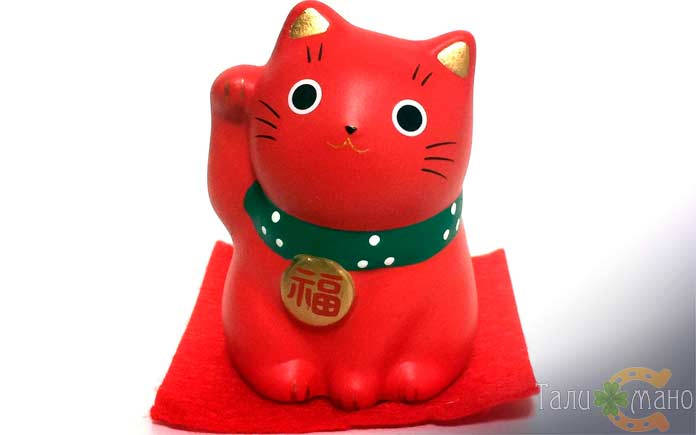
- What is maneki-neko and why does it bring good luck
- Story
- The meaning of
- You can not get everything at once.
- The higher the paw, the longer to wait for success
- Talisman with their own hands
- The meaning of popular figurines in Feng Shui:
- Legends of the cat that brings good luck
- Where to put a money cat according to feng shui
- The history of origin
- The history of the Goto-kujii temple
- The story of a courtesan named Usugumo
- Varieties and meanings of the talisman
- Types of figurines
- Asked a Japanese woman what a cat with a raised paw really means
- MANEKA NEKO ARRANGEMENT IN THE INTERIOR
- The right way to get rid of Maneki Neko
- Interesting Facts
What is maneki-neko and why does it bring good luck
Whether you've ever been to Japan or you know about its culture only by hearsay from documentaries and the Internet, you've probably noticed the figure of a cat with its paw upright, which the Japanese often display in store windows, restaurants, patinko rooms (slot machines), and so on.
A porcelain or ceramic cat with huge eyes is a kind of talisman, which, according to the Japanese, can bring happiness and good luck. If the maneki-neko ("alluring cat" or "attraction cat") has its right paw raised, it attracts money, and if it has its left paw, it attracts customers, which is, in fact, money, too.
There are also maneki-neko with two paws raised, and some "magic cats" even hold an oval gold coin worth ten million ryo. And why not, because such things attract to such things, right? And that's where this amazing cat came from and why it gained such popularity – I'll tell you further.
There are several legends (yes, that's right, the legends) relating to the origin of the maneki-neko, and each one, though amazing in its own way, is very much related to Japanese history.
In the history of Gotokuji Temple, a Japanese Buddhist temple, it is said that in 1615 its abbot took in a stray cat. At the time, the church was in a deplorable state, in need of major repairs, but there was barely enough money even for basic necessities. Not having a better option, the abbot complained to the cat: "Pussycat, I don't blame you for not helping, after all, you are only a cat. If you were human, then you could do something for us." The cat, as it is supposed to be, said nothing.
Some time later, the daimyo (prince) of the principality of Hikone Yi Naotaka, who was returning from a military campaign, passed by the temple. Suddenly the heaviest downpour hit him and his entourage. In the pitch-darkness of the night, the prince could barely make out the tree under which he had taken shelter from the rain. He would have never noticed the temple gate if it were not for the cat sitting by it, beckoning him with his paw as it seemed to him.
Story
Maneki-neko is the name of a Japanese talisman and amulet. Many believe that it brings good luck, wealth and happiness to its owner. This talisman represents a cat, which lifts up one of its paws.
The name "Maneki-neko" can be literally translated as "inviting cat".
This talisman, according to tradition, is made of ceramic and painted white, then painted with different patterns and additional shades. There are many legends about the origin of this amulet, which can often be heard by tourists who decide to visit Japan.
One of them tells of a very rich man who was passing through one of the holy places – Gotoku-ji Temple. At that moment, it began to rain, thunder rumbled and lightning flashed. The traveler decided to wait out the bad weather under a tree and go on, but suddenly he noticed a cat that seemed to call him to go into the temple and wait out the rain there. He went into the temple, and the very tree under which he had intended to hide was struck by lightning. It turns out that this cat was a real salvation for the rich man, so he gave orders to make a statue in honor of the animal, which is now a talisman for many people.
Another legend is associated with a girl of easy virtue, who loved cats. Once she had to visit the ladies' room at night, but her cat clung to her clothes, not allowing her to leave the room. A guard came running in, hearing the noise, and thinking the animal was rabid, cut off its head. The head subsequently ended up on the ceiling and grabbed the poisonous snake with its teeth. Thus the cat saved the girl's life. She missed her pet very much. Because of this, one of her customers, to make her happy, gave her a statue in the form of a cat.
There is another legend in which a cat also saved the life of his mistress. It tells of an old lady who lived with her cat. She was so poor that she could not even buy a piece of bread. Because of this, she had to sell her cat, but the money from its sale soon ran out. The old woman again starved to death, but one night she had a strange dream in which her former pet urged her to make statuettes in the form of kittens, in order to sell them later. The old woman decided to obey. As a result, the statuettes charmed people bought them very quickly, which saved the woman from starvation.
The meaning of
The Japanese believe that the statuette in the form of a cat attracts happiness, success and good luck. It is also considered that this talisman protects the apartment from thieves, and the raised paw of the cat, which seems to wave at her, symbolizes the invitation to the house of guests and other visitors, and, in addition, the figure itself in general helps improve relations between people.
It is because of this that in Japan Maneki-neko figurines can so often be seen in various retail outlets, in snack bars, in places where there are slot machines, in offices. It is not uncommon to see such figures at home of the Japanese.
If you go deeper into what a cat figurine means, you should pay attention to its color and pose.
You can not get everything at once.
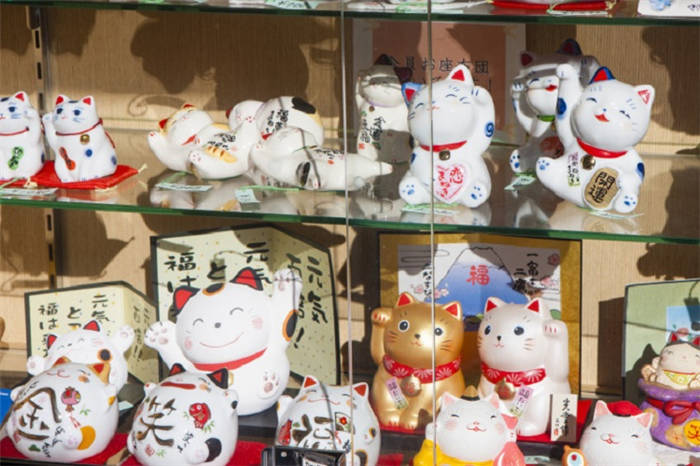
Today there are many varieties of maneki-neko: they can be both lying and sitting, and with two raised paws. For some reason, it is commonly believed that if a cat has both legs up, it attracts both money and social connections. But that's not the case. Having both paws up symbolizes a cat that gives up. Simply put, maneki neko with both paws up symbolizes defeat.
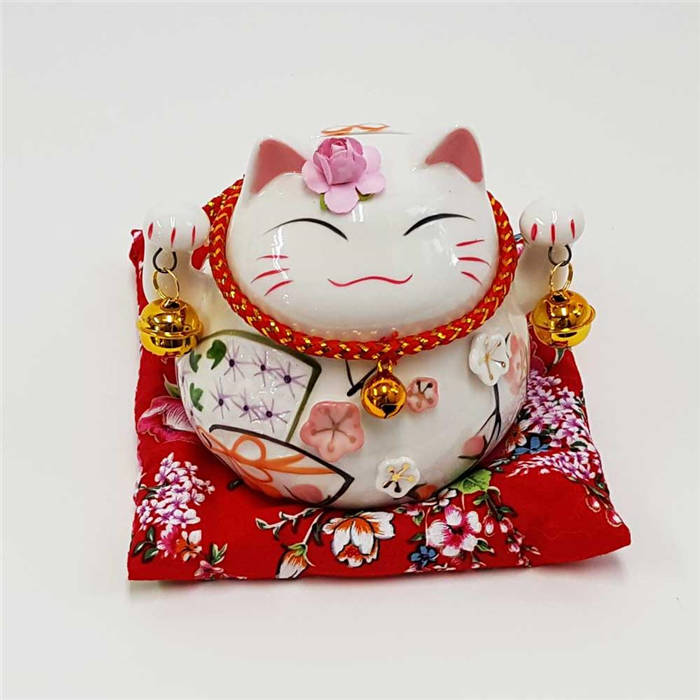
If you put such a talisman in your home or office, many projects and goals will not be achieved. It will seem that everything is about to happen, but at the last moment, everything will start to fall apart.
To make both money and customers come, you need to buy two cats: one with the left leg raised, the other with the right.
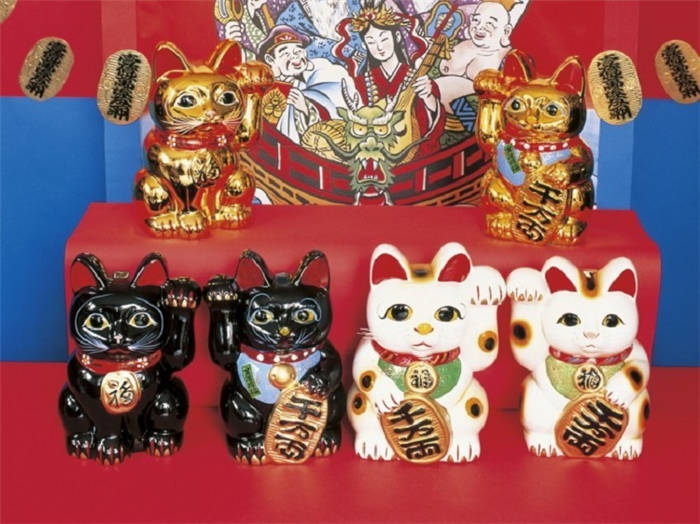
The higher the paw, the longer to wait for success
Also when buying maneki-neko it is necessary to pay attention to the height of raised foot: if it is below the ear, then luck will come to the owner of the talisman faster. If the foot is higher than the ear, then success will have to wait a little longer. Salesmen of talismans note that buyers more often buy cats with a paw below the ear. And this is natural: everyone wants to attract good luck quickly.
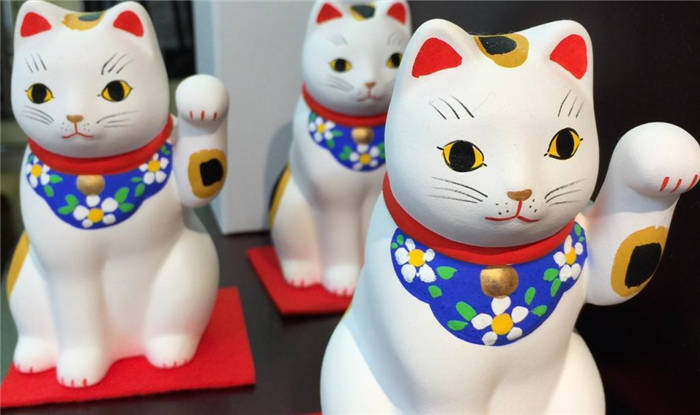
Talisman with their own hands
You can also make a statuette with your own hands from papier-mâché or polymer clay, as in the photo from the Internet. Some lovers of needlework felts cat figurines of wool or knit them from yarn. In any case, handmade talisman will bring you good luck much faster.
And if you give a figure of maneki-neko to someone, thus you can protect him from troubles and attract happiness in his house. Only don't forget that you should make a talisman with positive thoughts.
The meaning of popular figurines in Feng Shui:
Legends of the cat that brings good luck
There are many legends about why a cat is considered a symbol of good luck and wealth. We will tell you about the most popular ones.
According to the first ancient legend, a cat saved a nobleman who had lost his way in the woods from certain death.
It was raining heavily with thunder and lightning. The rich man was trying to hide under a tree.
As soon as he saw the cat and followed him, lightning struck the tree and burned it completely. The cat, however, led him to the temple.
According to the second legend, the cat lived in a very poor temple where the parishioners rarely looked.
And then one day the cat sat on the doorstep and raised his paw, calling people to him. The worshippers were attracted to the temple and were moved by the cat's behavior.
He appeared to her in a dream and recommended her to make his figure out of clay, promising good luck and riches in return.
So the woman did. A rich man who passed by bought the figurine for a large sum of money. Since then, the landlady has prospered.
As a talisman, the money cat Maneki Neko appeared only in the second half of the 19th century.
A cat with a raised left paw has a non-material beginning – it lures business partners, the right people, valuable information, that is, everything that is then transformed into money.
A cat with the raised right paw attracts directly material wealth.
There are also cats that have both paws raised. They attract all good things at once.
Such a kitty in the form of a pendant made of metal you can buy in the online store 12Monet.ru, the link will be at the end of this article.
The bib, often ornately ornamented, is associated with Jizo, the patron saint of children and travelers.
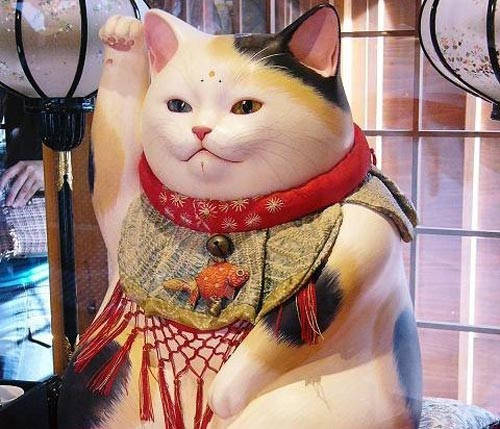
Stone sculptures of Jizo wear bibs, usually red, to make requests to him.
Before, the colors of Maneki-neko were not as varied as they are nowadays, but they had a certain meaning.
Where to put a money cat according to feng shui
A cat with a raised paw according to feng shui is recommended to put in the southeast to activate the zone of wealth.
Then the cat will be responsible for money management and good investments.
To strengthen the energy of money, you can put the cat in a pot of money and pour coins in it.
Most often, money cat Maneki-Neko put on the desk in the office.
Then, in addition to money and prosperity, they symbolize good luck and ward off loneliness.
In this interpretation, cats must necessarily wave their different paws.
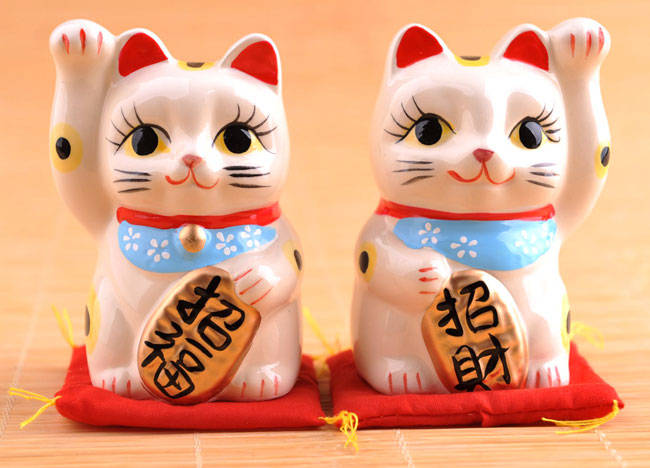
The cat sees well in the dark, so Maneki-Neko is able to ward off spirits invisible to humans but capable of harming them.
In our online store you can buy a pendant Maneki Neko , which can be carried around or hung on the money tree.
The history of origin
The origin of the figurine, one way or another, is associated with Japanese culture, and there are several legends that differ from each other.
The history of the Goto-kujii temple
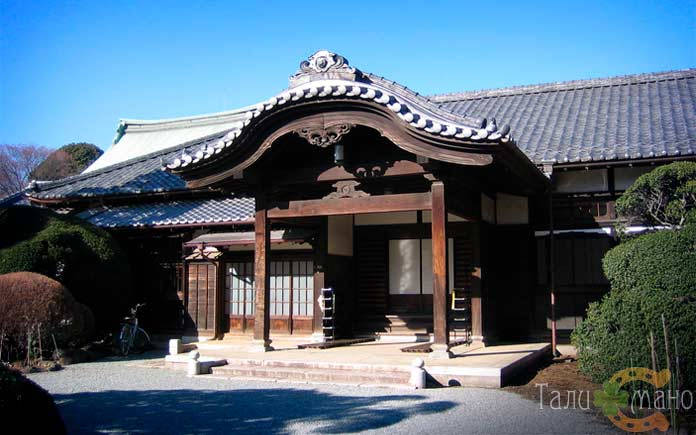
According to the legend, in 1615 Goto-kujii temple was in a dilapidated state and there was no money to repair it or properly maintain it. One day, the abbot of the temple picked up a stray cat in the street and heartily expressed his resentment at the injustice of fate. He complained that if the cat had been a human, it might have helped him out of his poverty and misfortune. Some time later, Prince Yi Naotaka was returning from a military campaign on a road near the temple.
Suddenly the sky became cloudy and it rained heavily. Iyi Naotaka hurried to shelter from the weather under a tall, perennial tree. He would not have noticed the gate leading to the temple if his attention had not been drawn to an unusually beckoning pawed cat. As soon as
the stunned prince crossed the threshold of the temple, lightning struck the tree, blowing it almost to pieces.
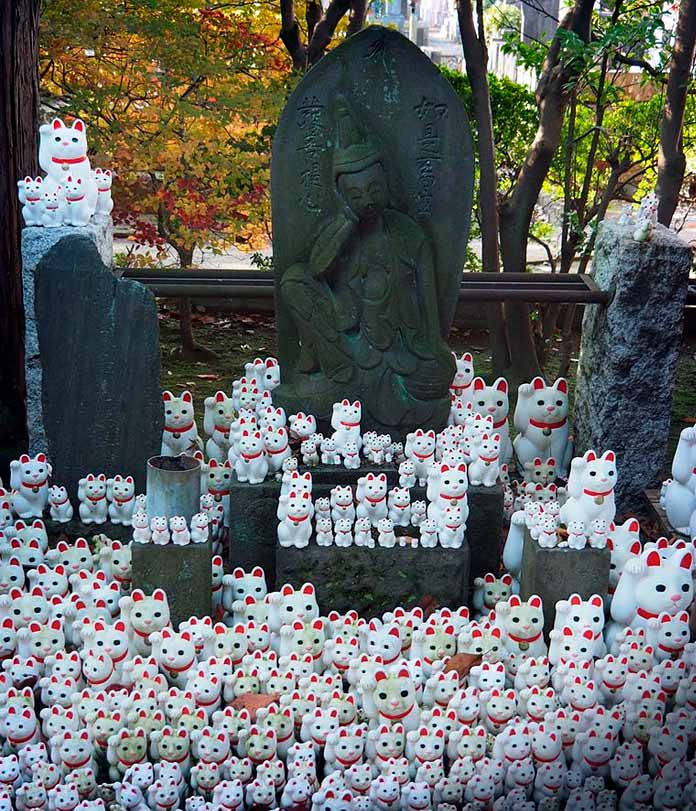
The incident made a huge impression on him. He talked to the abbot and not only gave money for the repair of the temple, but also dedicated his life to the care of this holy place. For more than four centuries the temple has stood, preserved to this day. In the spring, ceremonies are held there, dedicated to the cat, who played an important role in its history. By the way, one of the premises sells Maneki Neko figurines.
The story of a courtesan named Usugumo
The courtesan Usugumo of Yeshiwara was very fond of cats. In the middle of the night, Usugumo needed to leave the room, but one of the cats clung to the edge of her kimono. There was a shout, and a rushing guard cut off the poor animal's head. The head bounced off the ceiling and clawed at the lurking snake with its teeth. The woman longed for the cat that saved her life and, to comfort her, one of the guests gave her a statue in the form of a cat resembling Maneki neko.
Varieties and meanings of the talisman
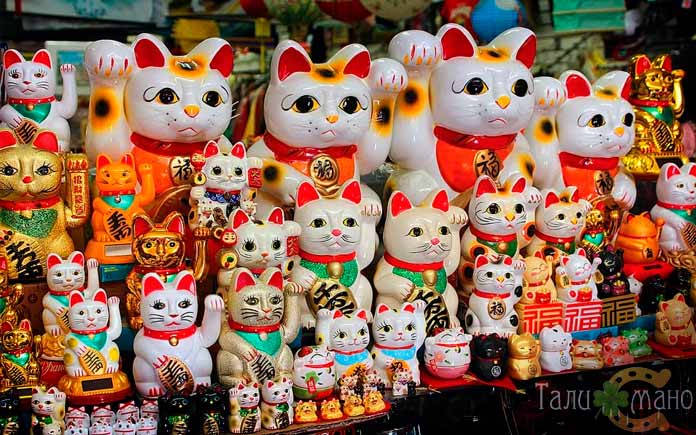
In Japan, Maneki neko is found with its right, left and two paws raised.
- The version with the waving left paw is the most common. It symbolizes networking between people and luring customers, which is why such figurines are especially often used in stores, restaurants, premises with slot machines and other places of mass gathering of people.
- The figurine with the raised right paw is acquired for attraction of material prosperity and good luck in affairs. Such a cat with a raised paw is found both in offices and in homes.
- As for the cat with two raised paws, this is an option for those who hope to get everything at once. Many people buy this kind of amulet to protect their homes from robbery and other troubles.
The standard colors of Maneki-neko are white, black, and orange. This kind of spotted coloring in cats is called a calico.
? Surprising fact! In Rus diversely colored cats were believed to bring good luck and prosperity to the house. The people called them "rich" and enjoyed special privileges. However, we have listed not all kinds of cats-talismans.
Types of figurines
The main types and purposes of figurines of cats, protecting against evil and attracting material prosperity:
- Sorcerer Cat . – The main talisman aimed at guaranteeing the attraction of good luck;
- Golden Cat – increases wealth and prosperity;
- Maneki-neko cat symbol – money talisman, ensuring success in financial activities;
- Japanese good luck cat with two raised paws – protects against bankruptcy, as well as against thieves;
- Spotted Chinese cat with a paw – the luckiest, brings good luck in all affairs and endeavors;
- Royal kitty cat – is intended as a gift for dignitaries, managers, and executives;
- The militant Maneki-neko – helps to overcome weaknesses and set oneself up for success.
Asked a Japanese woman what a cat with a raised paw really means
Hi everyone, my name is Vera. I am a Japanese translator and I worked in a tour company for 5 years. I've accompanied Russian tourists in Japan several times. Once we went with just a bunch of girls.
Our plan was to go to Kamakura to the temple, where the statue of the Big Buddha is. From the station we decided to walk. It was a long walk, but we walked around and looked in all the Kamakura stores.
One of the stores sold kittens with a paw. It's called "maneki-neko" in Japanese. There was a sea of them! Just figurines, jewelry with kittens, postcards with kittens. There was music playing in the store all the time – one music box after another.
I decided to buy a cat with a paw, but I noticed that there were cats with the right paw up and those with the left. And in the corner there were kittens with two legs up. I used to think there was no difference, but then I decided to ask the consultant in the store.
This cat has its paw raised above its head and ears, which means it will attract more guests and customers than the other cats. https://kakakumag.com/amp/hobby/%3Fid=11027
✅ A kitty with its right leg raised attracts money. You can buy such a kitty for your home or as a gift. He is said to help you win the lottery.
✅ Kitty with a raised left paw attracts guests and customers. Businessmen buy such cats and put them in their stores and restaurants. More customers – more revenue.
✅ A kitty with two upraised paws attracts both money and guests. There are also cats, which have a coin in their right paw and the left one is just raised. Such manek-neko also attracts both money and guests.
A Japanese woman said that the efficiency of a cat depends on the height of the raised paws! The higher the paws, the more money and guests. The coolest kitty is the one with his paws raised above his head and ears.
MANEKA NEKO ARRANGEMENT IN THE INTERIOR
This figurine works very well when placed near the entrance to a dwelling. In a private home, it can even be located outside, and the most appropriate place for it is in the hallway or in any part of the apartment, but let it look at the front doors.
The same rule applies to all premises where the statue is placed, be it a store, a beauty salon or an office.
The effect of Maneka will not be much stronger if you place it on a Japanese red napkin or a pad.
If you decided to buy Maneki neko as a present, you should tell its history to the person you gave it as a present and wish the future owner all the good luck. Such statuettes not only decorate the interior, but also level the energy of the house, making it peaceful.
The right way to get rid of Maneki Neko
Any magical object created for the benefit of man requires respect. In Japan, a spent talisman is ceremonially disposed of in temples or in special cat cemeteries. These places are considered guardians of the energy of animal spirits. For Europeans, esotericists recommend using the traditional ritual of burying the amulet. The statuette should be wrapped in a clean cloth (bag) along with coarse salt and buried under a tree in a secluded place. Thank the beckoning cat for its assistance.
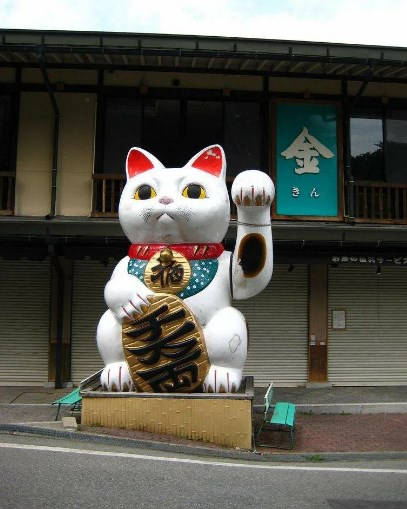
Interesting Facts
In the early twenty-first century the city of Okayama opened a museum of remarkable cats of all stripes and sizes that bring good luck. The guests are greeted by Maneki Neko, who is 75 cm high and weighs 30 kg. The robot cat "sees" a car or a person with the help of special sensors. The welcoming waving paw creates a pleasant illusion of personal communication with the visitor.
Traditional Japanese Wagashi is just as popular as TIRAMIS or CHIZKAKA. For centuries, such sweets have been prepared for celebrations and offered to deities. The modern design motifs are Maneki Neko, a symbol of good luck, happiness and prosperity, revered in Japan. Products are made with the highest skill and good-natured humor. Each dessert is made by hand and is unique.
According to statistics, the image of the alluring cat posted on the Internet, 2 times more views of photos of celebrities.






